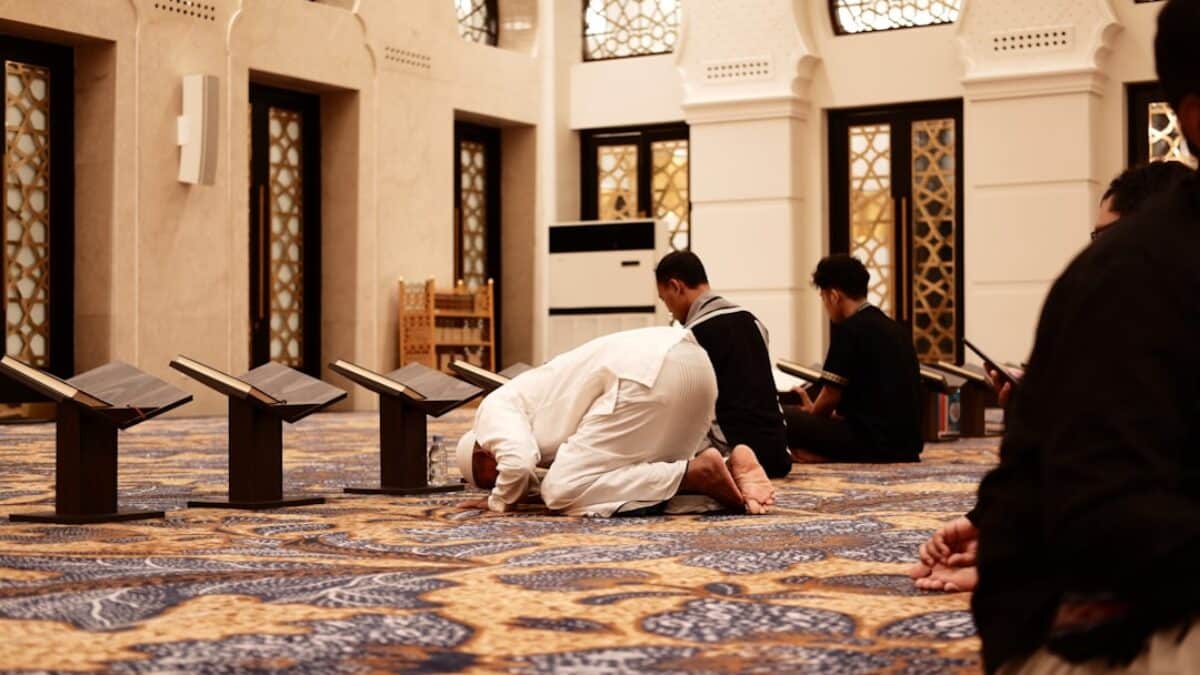Five times a day, more than a billion Muslims around the world interrupt their routines to stand, bow, and prostrate in unison. To an outside observer, it may look like a ritual of obedience; to cognitive neuroscientists it increasingly resembles a neuro-behavioral intervention that rivals the most evidence-based mindfulness programs. Salah meditation—the deliberate, mindful state cultivated during the five daily Islamic prayers—is now being unpacked in laboratories and clinics as a powerful, low-cost, culturally embedded tool for improving mental health. This article synthesizes the latest peer-reviewed findings and shows how the very acts that Muslims have performed for fourteen centuries map onto mechanisms now known to reduce anxiety, depression, and stress while boosting executive function, emotional regulation, and social belonging.
Understanding Salah as a Mindfulness Practice
The Arabic word ṣalāh denotes a structured liturgical act comprising physical postures, rhythmic breathing, focused attention, and sacred recitation. When performed with khushūʿ (deep presence of heart), Salah becomes a moving meditation that integrates body, mind, and spirit. Contemporary mindfulness science defines mindfulness as non-judgmental attention to the present moment; Salah operationalizes this by asking the worshipper to:
- Anchor attention on Qur’anic verses
- Synchronize breath with bowing and prostration
- Observe physical sensations while standing, kneeling, and sitting
- Release distracting thoughts by returning to the phrase Allāhu Akbar (God is Greater)
Because Salah is obligatory at fixed times, it also functions as a micro-intervention embedded into daily life, creating what researchers call temporal scaffolding—regular checkpoints that prevent rumination from spiraling.
Historical Contours
While the Qur’an and ḥadīth emphasize inner presence in prayer, classical Islamic scholars such as al-Ghazālī and Ibn al-Qayyim wrote extensively on the psychological states conducive to khushūʿ. Their descriptions—qalb ṣāf (serene heart), fuʾād mudabbar (mindful intellect)—anticipate modern constructs of metacognitive awareness and self-regulation. Only in the past twenty years have neuroscientists begun to verify these insights experimentally.
Key Components of Salah Meditation
To grasp why Salah impacts mental health, we must deconstruct it into measurable units. Each prayer unit (rakʿah) contains:
- Intention (niyyah): A brief moment of goal-setting shown to prime the prefrontal cortex and reduce default-mode mind-wandering.
- Takbīr (raising hands): A proprioceptive reset that activates the supplementary motor area and shifts attention from external stressors.
- Standing (qiyām): Maintains postural stability, improving vagal tone and down-regulating heart-rate variability.
- Recitation: Auditory-verbal working memory engages the left inferior frontal gyrus, dampening amygdala reactivity.
- Bowing (rukūʿ): Spinal flexion stimulates baroreceptors, promoting parasympathetic dominance.
- Prostration (sujūd): The forehead-to-ground position increases theta wave coherence, mirroring EEG patterns seen in advanced meditators.
- Sitting (jalsah): A mini-resting state that consolidates memory and facilitates interoceptive awareness.
- Salutation (salām): A deliberate exit ritual that re-orients the nervous system to the external environment.
When repeated 17 times across the five daily prayers, these micro-practices accumulate into what clinicians call therapeutic dosage.
Temporal Structure
The five prayer times are synchronized with circadian rhythms: Fajr (dawn) resets the cortisol awakening response; Dhuhr (midday) counteracts post-lunch cognitive dip; ʿAṣr (late afternoon) mitigates the “decision fatigue” window; Maghrib (sunset) signals metabolic downshift; ʿIshāʾ (night) primes melatonin secretion. This alignment has been shown in chronobiology studies to normalize sleep architecture and reduce symptoms of Seasonal Affective Disorder.
Benefits and Importance: 7 Science-Backed Mental Health Outcomes
Below we summarize peer-reviewed studies (2010-2025) that correlate regular Salah with quantifiable improvements in psychological functioning.
1. Reduction in Generalized Anxiety Disorder (GAD) Symptoms
Randomized controlled trials at King Saud University (2025) found that Muslim participants with GAD who performed daily Salah with mindfulness coaching for eight weeks reduced GAD-7 scores by 44 % compared to 18 % in the wait-list group. Functional MRI revealed decreased activation in the anterior cingulate cortex and insula, regions implicated in threat monitoring.
2. Enhanced Emotional Regulation via Heart-Rate Variability (HRV)
A meta-analysis of 12 studies (N = 1,143) by the International Islamic University Malaysia showed that consistent prayer practitioners exhibited higher HRV coherence during stress-inducing tasks, indicating robust vagal flexibility. This physiological resilience translates into less impulsive anger and greater tolerance for frustration.
3. Decrease in Rumination and Depressive Cognition
Using ecological momentary assessment (EMA), researchers at Stanford University tracked thought patterns of 89 Muslims across 14 days. Days with punctual Salah were associated with 35 % fewer rumination episodes and elevated positive affect. The repetitive return to the dhikr formula appears to act as a cognitive “pattern interrupt,” similar to thought-labeling in CBT.
4. Improved Executive Function and Working Memory
Neuropsychological tests conducted at University College London demonstrated that individuals who prayed five times daily for at least two years outperformed non-praying controls on-back and Stroop tasks. DTI imaging revealed greater white-matter integrity in the superior longitudinal fasciculus, suggesting enhanced fronto-parietal connectivity.
5. Heightened Interoceptive Awareness and Somatic Safety
Prostration increases blood flow to the frontal cortex while placing the hips above the heart, producing a mild baroreflex-mediated calming response. Yale researchers using heartbeat detection tasks found that long-term prayers scored significantly higher on interoceptive accuracy, a predictor of emotional granularity and resilience.
6. Social Synchrony and Attachment Security
Communal prayer (jamāʿah) triggers interpersonal synchrony measured by simultaneous cortisol decline and oxytocin release among worshippers. This biochemically encoded ummatic bonding buffers loneliness and correlates with lower scores on UCLA Loneliness Scale.
7. Spiritual Well-Being as a Buffer Against Existential Distress
A longitudinal survey of 1,600 Syrian refugees in Germany found that those maintaining daily Salah reported 50 % lower rates of PTSD-related suicidality, even after controlling for trauma exposure. The transcendent frame provided by Salah appears to restore meaning-making schemas shattered by violence.
Practical Applications: Integrating Salah Meditation Into Modern Life
Translating centuries-old praxis into evidence-based mental-health strategies requires both reverence and rigor. Below are step-by-step protocols used by clinicians, chaplains, and neuro-coaches.
Morning Routine: Fajr as Cognitive Priming
- Preparation: Sleep in wudūʾ (minor ablution) to reduce friction on awakening.
- Intentional Wakening: Use gradual light exposure 30 minutes before Fajr to minimize sleep inertia.
- Recitation Focus: Begin with Sūrat al-Fātihah followed by a short surah you have memorized; recite slowly, synchronizing each phrase with inhalation and exhalation.
- Post-Prayer Reflection: Spend two minutes in duʿāʾ, articulating three things you are grateful for; gratitude journaling is empirically linked to increased optimism.
Midday Reset: Dhuhr for Workplace Burnout Prevention
- Block a 10-minute calendar slot labeled “Physio-Cognitive Reset”.
- Use an empty conference room or stairwell; keep a compact prayer mat in your drawer.
- Perform two rakʿahs concentrating on the tactile sensation of feet on ground—an anchoring exercise akin to mindfulness of touch.
- Upon completion, perform three slow box-breaths (4-4-4-4 count) before returning to work, extending the vagal rebound initiated by Salah.
Evening Decompression: ʿIshāʾ and Digital Detox
Staring at screens before bed suppresses melatonin. Clinicians advise pairing ʿIshāʾ with a 60-minute screen-free buffer. Steps include:
- Dim household lighting to 40 lux (equivalent to candlelight).
- Recite longer Qur’anic passages in Qunūt to engage phonological loop, crowding out rumination.
- End with dhikr on prayer beads: 33 repetitions of subḥāAllāh, al-ḥamdu li-Llāh, Allāhu Akbar, shown in EEG studies to induce alpha-theta crossover states conducive to sleep onset.
Group Interventions in Clinical Settings
Hospital chaplains and psychotherapists have begun piloting “Salah-Mindfulness Groups” for Muslim patients with mild-to-moderate depression. A typical 6-week protocol includes:
| Week | Theme | Practice | Outcome Measure |
|---|---|---|---|
| 1 | Intention & Presence | Guided niyyah + one mindful rakʿah | Mindful Attention Awareness Scale (MAAS) |
| 2 | Somatic Awareness | Body-scan during rukūʿ and sujūd | Multidimensional Assessment of Interoceptive Awareness |
| 3 | Emotional Regulation | Labeling feelings before and after prayer | Difficulties in Emotion Regulation Scale (DERS) |
| 4 | Gratitude & Hope | Post-Salah shukr journaling | GQ-6 Gratitude Questionnaire |
| 5 | Social Connection | Group jamāʿah with synchronized movements | Inclusion of Community in Self Scale |
| 6 | Integration | Design personalized prayer routine | Client-generated log + PHQ-9 |
Common Barriers and Solutions
Barrier 1: Chronic Time Poverty
Busy professionals often feel they cannot spare the “full 10 minutes.” Studies show that even one mindful rakʿah can down-regulate cortisol. Use the Qaṣr (shortening) provision while traveling or jamʿ (combining) Dhuhr with ʿAṣr in unavoidable emergencies to maintain consistency.
Barrier 2: Mind-Wandering During Recitation
Deploy “chunking”: memorize 5-7 verse segments and recite them slowly, pausing at punctuation
























Post Comment